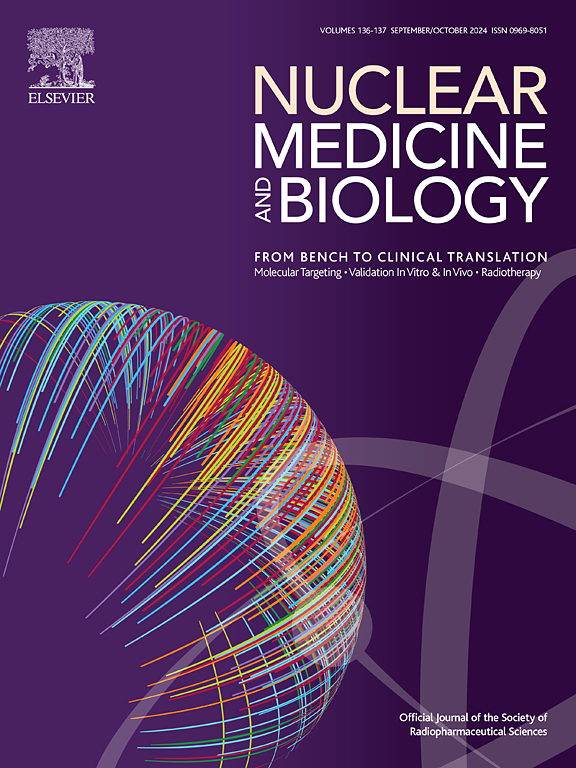烟碱乙酰胆碱受体成像与[18F]ASEM骨骼肌去神经支配:周围神经肌肉疾病的新评估
IF 3.6
4区 医学
Q1 RADIOLOGY, NUCLEAR MEDICINE & MEDICAL IMAGING
引用次数: 0
摘要
目的尽管针刺肌电图(nEMG)具有侵入性和主观性,但仍是评估周围神经损伤的标准方法。在动物肌肉去神经支配神经损伤模型中观察到α -7烟碱乙酰胆碱受体(alpha7-nAChR)表达增加。因此,我们使用[18F]ASEM正电子发射断层扫描(PET)研究骨骼肌去神经支配后alpha7-nAChR表达的时间特征,并测试神经损伤严重程度与[18F]ASEM PET摄取强度之间的相关性。方法建立骨骼肌失神经支配大鼠坐骨神经损伤模型。首先,[18F]在全神经损伤模型中,随着时间的推移同时进行ASEM PET和nEMG。接下来,我们使用部分神经损伤模型来建立信号强度作为神经损伤严重程度的函数。最大标准化摄取值(SUVmax)和病变与正常比(LNR)用于半定量表征[18F]ASEM摄取。结果ASEM摄取增加[18F]开始于去神经支配后1天(SUVmax,去神经支配,1.00±0.32;SUVmax,对照组,0.62±0.23;P & lt;0.05;N = 7),持续至最后12周时间点。LNR在去神经支配后1天也增加,与nEMG相比,检测到更早的变化。去神经支配骨骼肌摄取[18F]ASEM信号强度与神经损伤严重程度显著相关(SUVmax与神经损伤严重程度的Spearman相关系数= 0.82;LNR与神经损伤严重程度Spearman相关系数= 0.75;P <;0.05)。结论[18F]靶向alpha7-nAChR的ASEM PET可用于评估骨骼肌去神经支配的效果。这种分子成像方式具有周围神经损伤早期评估的潜力,也可以促进损伤严重程度的评估。本文章由计算机程序翻译,如有差异,请以英文原文为准。
![Nicotinic acetylcholine receptor imaging with [18F]ASEM for skeletal muscle denervation: A novel assessment for peripheral neuromuscular disorders](https://img.booksci.cn/booksciimg/2025-4/102303232401776059411.jpg)
Nicotinic acetylcholine receptor imaging with [18F]ASEM for skeletal muscle denervation: A novel assessment for peripheral neuromuscular disorders
Purpose
Despite its invasive and subjective nature, needle electromyography (nEMG) remains a standard method for evaluating peripheral nerve injuries. Increased alpha-7 nicotinic acetylcholine receptor (alpha7-nAChR) expression has been observed in an animal nerve injury model of muscle denervation. Hence, we used [18F]ASEM positron emission tomography (PET) to investigate the temporal characteristics of alpha7-nAChR expression following skeletal muscle denervation, and tested the correlation between nerve injury severity and [18F]ASEM PET uptake intensity.
Methods
We established a sciatic nerve injury rat model of skeletal muscle denervation. First, [18F]ASEM PET and nEMG were conducted simultaneously in the complete nerve injury models over time. Next, we used a partial nerve injury model to establish signal intensity as a function of nerve injury severity. Maximum standardized uptake value (SUVmax) and lesion-to-normal ratio (LNR) were used to semi-quantitatively represent [18F]ASEM uptake.
Results
Increased [18F]ASEM uptake began 1 day after denervation (SUVmax, denervation, 1.00 ± 0.32; SUVmax, control, 0.62 ± 0.23; P < 0.05; n = 7) and lasted to the final 12-week time point. LNR also increased 1 day after denervation, detecting earlier changes compared to nEMG. The signal intensity of [18F]ASEM uptake in denervated skeletal muscle was significantly associated with nerve injury severity (Spearman correlation coefficient between SUVmax and nerve injury severity = 0.82; Spearman correlation coefficient between LNR and nerve injury severity = 0.75; both P < 0.05).
Conclusion
[18F]ASEM PET targeting the alpha7-nAChR can be used to assess effects of skeletal muscle denervation. This molecular imaging modality holds potential for early assessment of peripheral nerve injury and may also facilitate the evaluation of the injury severity.
求助全文
通过发布文献求助,成功后即可免费获取论文全文。
去求助
来源期刊

Nuclear medicine and biology
医学-核医学
CiteScore
6.00
自引率
9.70%
发文量
479
审稿时长
51 days
期刊介绍:
Nuclear Medicine and Biology publishes original research addressing all aspects of radiopharmaceutical science: synthesis, in vitro and ex vivo studies, in vivo biodistribution by dissection or imaging, radiopharmacology, radiopharmacy, and translational clinical studies of new targeted radiotracers. The importance of the target to an unmet clinical need should be the first consideration. If the synthesis of a new radiopharmaceutical is submitted without in vitro or in vivo data, then the uniqueness of the chemistry must be emphasized.
These multidisciplinary studies should validate the mechanism of localization whether the probe is based on binding to a receptor, enzyme, tumor antigen, or another well-defined target. The studies should be aimed at evaluating how the chemical and radiopharmaceutical properties affect pharmacokinetics, pharmacodynamics, or therapeutic efficacy. Ideally, the study would address the sensitivity of the probe to changes in disease or treatment, although studies validating mechanism alone are acceptable. Radiopharmacy practice, addressing the issues of preparation, automation, quality control, dispensing, and regulations applicable to qualification and administration of radiopharmaceuticals to humans, is an important aspect of the developmental process, but only if the study has a significant impact on the field.
Contributions on the subject of therapeutic radiopharmaceuticals also are appropriate provided that the specificity of labeled compound localization and therapeutic effect have been addressed.
 求助内容:
求助内容: 应助结果提醒方式:
应助结果提醒方式:


